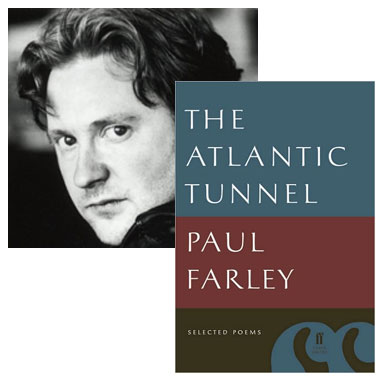Paul Farley, “Johnny Thunders Said”

You can’t put your arms around a memory.
The skin you scuffed climbing the black railings
of school, the fingertips that learned to grip
the pen, the lips that took that first kiss
are gone, my friend. Nothing has stayed the same.
The brain? A stockpot full of fats and proteins
topped up over a fire sotked and tended
a few decades. Only the bones endure,
stilt-walking trhough a warm blizzard of flesh,
making sure the whole thing hangs together,
our lifetimes clinging on as snow will lag
bare branches, magnifying them mindlessly.
Dear heart, you’ve put a brave face on it, but know
exactly where the hugs and handshakes go.
The Atlantic Tunnel is a selection of poems from four previous collections by Paul Farley; the poem above is immediately preceded by “Tramp in Flames,” the title poem of a volume shortlisted for the Griffin Poetry Prize…
Other Farley poems include “Monopoly” (published in The Poem) and “Cyan” (Granta), the latter of which leads off the section of new poems in The Atlantic Tunnel. New Yorkers will have a chance to hear more from Farley Tuesday night; he’s reading at 192 Books with Paul Muldoon.
Embedding has been disabled for the video of Farley reciting “Liverpool Vanishes for a Billionth of a Second,” but I encourage you to go have a look.
16 May 2010 | poetry |
Tatjana Soli and Fiction That Leaps into Danger

The Lotus Eaters opens in the chaotic moments before the fall of Saigon, then jumps back in time, showing how its three main characters came together as combat photographers in the early years of America’s involvement in the Vietnam War. I’m still in the first half of Tatjana Soli‘s story, but I’m captivated with the interlocking relationships, and with how she manages to capture the intricacies of working in a visual art form through verbal language. Her emotional commitment to this story comes through on every page, and I wanted to hear more from her about what drove her to tell this story, about these people…
One of the more fascinating things that happen to you as an author with a book out is the experience of bookstore events where readers come up to you to discuss your characters. This is both immensely gratifying and surreal. For years, this was a private relationship, and now suddenly it’s like you and your characters are on a reality show. Lately, going around to readings and talking about my novel, I’ve had readers want to discuss my main character, Helen: “She’s reckless.” I’ve also heard: “She makes me angry.” And whispered: “Who in their right mind would do this?” I understand. I’m sympathetic. I shuffle my feet. After all, I’ve been living with her for years.
Ten years ago, I came across a picture of a woman photojournalist in Vietnam who wore pearl earrings. Women in that war? And why the earrings? That mystery led me to discover a whole tribe of Amazon-like women that I had never been aware of before: from Dickey Chapelle and Catherine Leroy in Vietnam to contemporary photojournalists such as Stephanie Sinclair and Margaret Moth. There were other female journalists, writers, but photographers fascinated me for one simple reason: they can’t fake it. As in the famous Robert Capa quote: “If your pictures aren’t good enough you aren’t close enough.” Maybe the same can be said for writers. We are always trying to create fiction in which the reader can get as close as possible to the characters, but sometimes that takes him or her to an uncomfortable place. How to understand the seeming recklessness of a character, her hunting out of danger?
15 May 2010 | guest authors |

 Our Endless and Proper Work is my new book with Belt Publishing about starting (and sticking to) a productive writing practice.
Our Endless and Proper Work is my new book with Belt Publishing about starting (and sticking to) a productive writing practice. 
